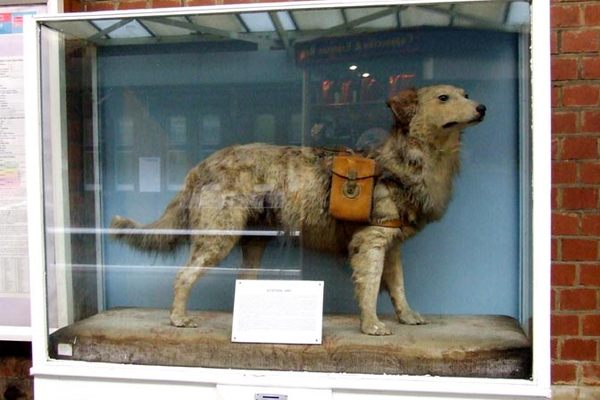AO Edited
Balto the Sled Dog
The heroic sled dog of the 1925 serum run is preserved in taxidermy.
In 1925, snowbound Nome, Alaska, was hit with an outbreak of incredibly contagious diphtheria, with the antidote miles away in Anchorage. With plane delivery impossible due to the conditions, the only way to get the serum to Nome and combat the fatal outbreak was with a relay of sled dog teams on the Iditarod Trail.
From Anchorage to Nome, a relay of dog sleds passed the serum off, until it reached the final leg with Gunner Kaassen and his team led by a black Siberian husky named Balto. This last stretch was still about 54 miles, the temperature remained below -40 degrees Fahrenheit for the duration and brutal winds threw a blizzard of snow in all directions. (Despite these dire conditions, the most hazardous leg of the race was actually covered earlier by Leonhard Seppala with his team led by Togo.)
While Kaassen couldn’t see where they were going, Balto never faltered and pressed on through the whiteout conditions. They arrived in Nome on February 2, 1925.
Balto was heralded as a hero throughout the country, with a statue of him even being placed in Central Park in his honor (although the monument was meant to honor all the dogs that worked to bring the serum to Nome). A two-reel film called “Balto’s Race to Nome” was also made by Sol Lesser with the dogs (although no print now remains).
However, his fame waned and he and the other sled dogs were taken by Kaassen on the vaudeville circuit to make a bit of money, with the dogs eventually winding up in bad shape in a Los Angeles dime museum. That’s where George Kimble, a Cleveland businessman, found them, and, shocked at their poor state, campaigned to raise the “Balto Fund” to collect the $2,000 being asked for them. A success, the movement brought Balto and his six fellow sled dogs to Cleveland in 1927, where they lived in comfort at the zoo. Balto rested there into his old age until his death on March 14, 1933 at the age of 14. After he died, his body was taxidermied and kept in the Cleveland Museum of Natural History, where it remains today.
Although Balto himself may be something of a forgotten icon, each year the annual Iditarod Trail Sled Dog Race is held in commemoration of that treacherous and courageous race to Nome. And the 1995 Universal Pictures animated film of the same name is a reminder that his legacy continues to carry on as the years go by.
Update as of January 2023: Balto is temporarily off exhibit until further notice.
Know Before You Go
Balto is very easy to find. He resides in a case at the Natural History Museum near the Arctic animals, toward the rear of the main atrium. To the right of his display are pamphlets and other material with details of his history.

























Follow us on Twitter to get the latest on the world's hidden wonders.
Like us on Facebook to get the latest on the world's hidden wonders.
Follow us on Twitter Like us on Facebook